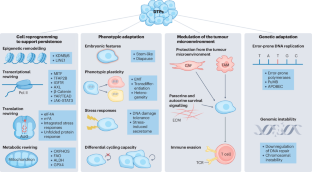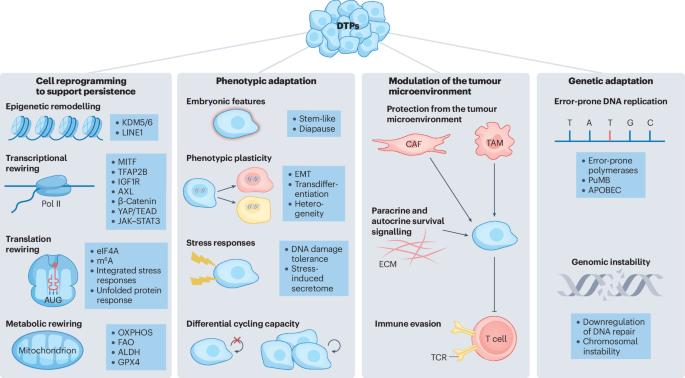癌症耐药持久细胞:从生物学问题到临床机遇
IF 72.5
1区 医学
Q1 ONCOLOGY
引用次数: 0
摘要
抗药性的出现是对抗癌疗法有效性的最大挑战。对立的研究方法揭示了耐药 "持久细胞"(DTP)在抗药性中的重要作用。虽然人们早已认识到细菌群体对抗生素产生了耐药性,但 DTPs 在各种癌症类型中的存在只是在过去二十年中才被发现,但其生物学的一些方面仍然是个谜。在此,我们将深入研究 DTPs 的生物学特性,并探索追踪和靶向它们的潜在策略。最新研究结果表明,DTPs 具有显著的可塑性,能够在不同细胞状态之间转换,从而在单个肿瘤内形成不同的 DTP 表型。然而,确定 DTPs 的生物学特征一直是一项挑战,部分原因是克隆动态与影响其表型的组织特异性因素之间存在复杂的相互作用。此外,DTPs 与肿瘤微环境之间的相互作用,包括它们逃避免疫监视的潜力,仍有待发现。最后,人们对 DTP 衍生耐药性的机制及其与临床结果的相关性仍然知之甚少。本路线图旨在全面概述 DTPs 领域,包括过去在阐明其生物学特性方面所取得的成就和当前所做的努力。我们还讨论了未来技术进步在帮助揭示 DTPs 特征方面的前景,并提出了可根除 DTPs 的新型治疗策略。本文章由计算机程序翻译,如有差异,请以英文原文为准。


Cancer drug-tolerant persister cells: from biological questions to clinical opportunities
The emergence of drug resistance is the most substantial challenge to the effectiveness of anticancer therapies. Orthogonal approaches have revealed that a subset of cells, known as drug-tolerant ‘persister’ (DTP) cells, have a prominent role in drug resistance. Although long recognized in bacterial populations which have acquired resistance to antibiotics, the presence of DTPs in various cancer types has come to light only in the past two decades, yet several aspects of their biology remain enigmatic. Here, we delve into the biological characteristics of DTPs and explore potential strategies for tracking and targeting them. Recent findings suggest that DTPs exhibit remarkable plasticity, being capable of transitioning between different cellular states, resulting in distinct DTP phenotypes within a single tumour. However, defining the biological features of DTPs has been challenging, partly due to the complex interplay between clonal dynamics and tissue-specific factors influencing their phenotype. Moreover, the interactions between DTPs and the tumour microenvironment, including their potential to evade immune surveillance, remain to be discovered. Finally, the mechanisms underlying DTP-derived drug resistance and their correlation with clinical outcomes remain poorly understood. This Roadmap aims to provide a comprehensive overview of the field of DTPs, encompassing past achievements and current endeavours in elucidating their biology. We also discuss the prospect of future advancements in technologies in helping to unveil the features of DTPs and propose novel therapeutic strategies that could lead to their eradication. Resistance to therapy remains the biggest challenge to achieving cures in patients with cancer. In this Roadmap, Russo et al. overview the field of cancer drug-tolerant persister cells providing paths to advance our understanding of their biology with innovative technologies and recommend strategies to therapeutically target them to ensure that more prolonged responses are achieved in patients with cancer.
求助全文
通过发布文献求助,成功后即可免费获取论文全文。
去求助
来源期刊

Nature Reviews Cancer
医学-肿瘤学
CiteScore
111.90
自引率
0.40%
发文量
97
审稿时长
6-12 weeks
期刊介绍:
Nature Reviews Cancer, a part of the Nature Reviews portfolio of journals, aims to be the premier source of reviews and commentaries for the scientific communities it serves. The correct abbreviation for abstracting and indexing purposes is Nat. Rev. Cancer. The international standard serial numbers (ISSN) for Nature Reviews Cancer are 1474-175X (print) and 1474-1768 (online). Unlike other journals, Nature Reviews Cancer does not have an external editorial board. Instead, all editorial decisions are made by a team of full-time professional editors who are PhD-level scientists. The journal publishes Research Highlights, Comments, Reviews, and Perspectives relevant to cancer researchers, ensuring that the articles reach the widest possible audience due to their broad scope.
 求助内容:
求助内容: 应助结果提醒方式:
应助结果提醒方式:


